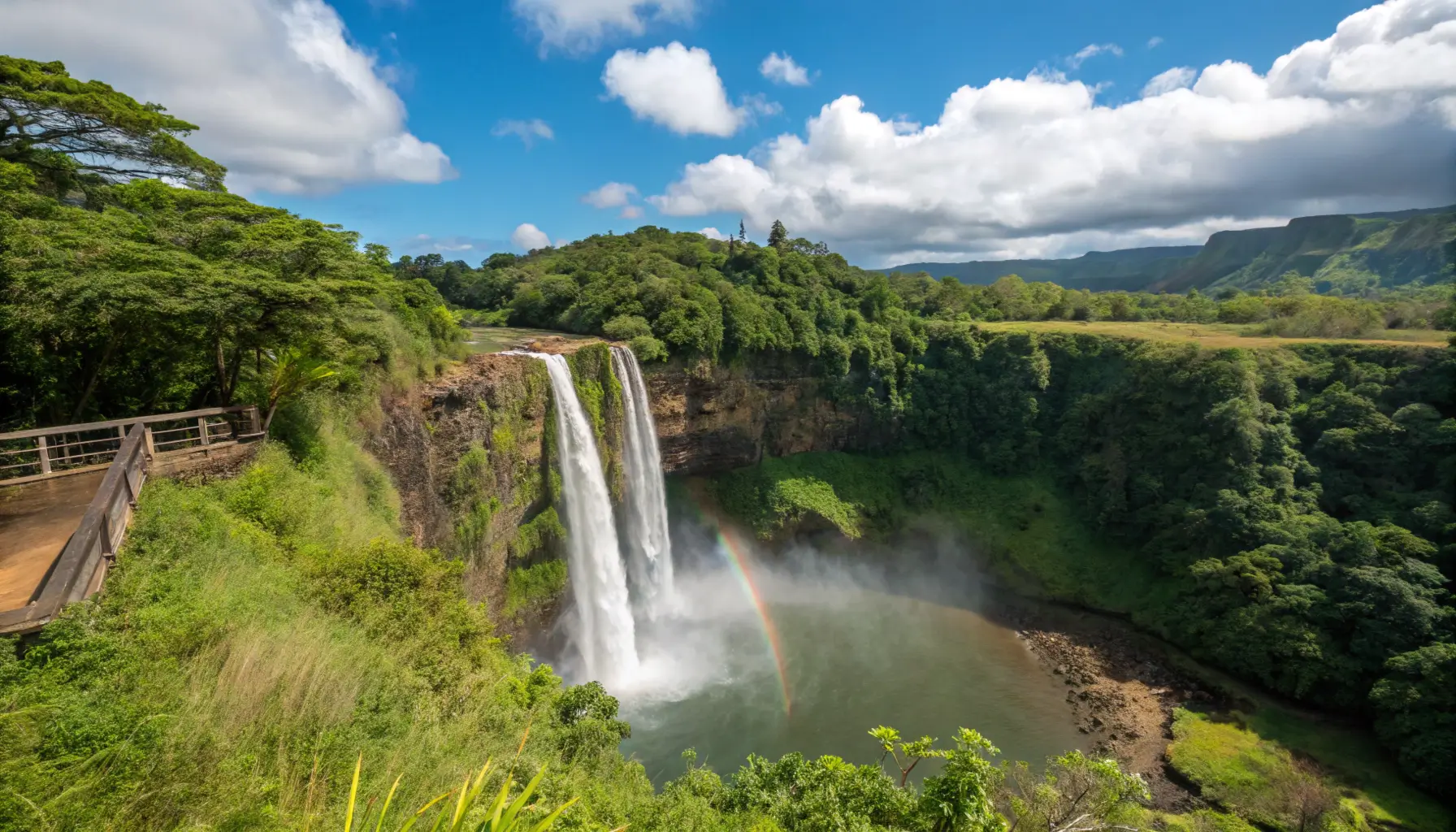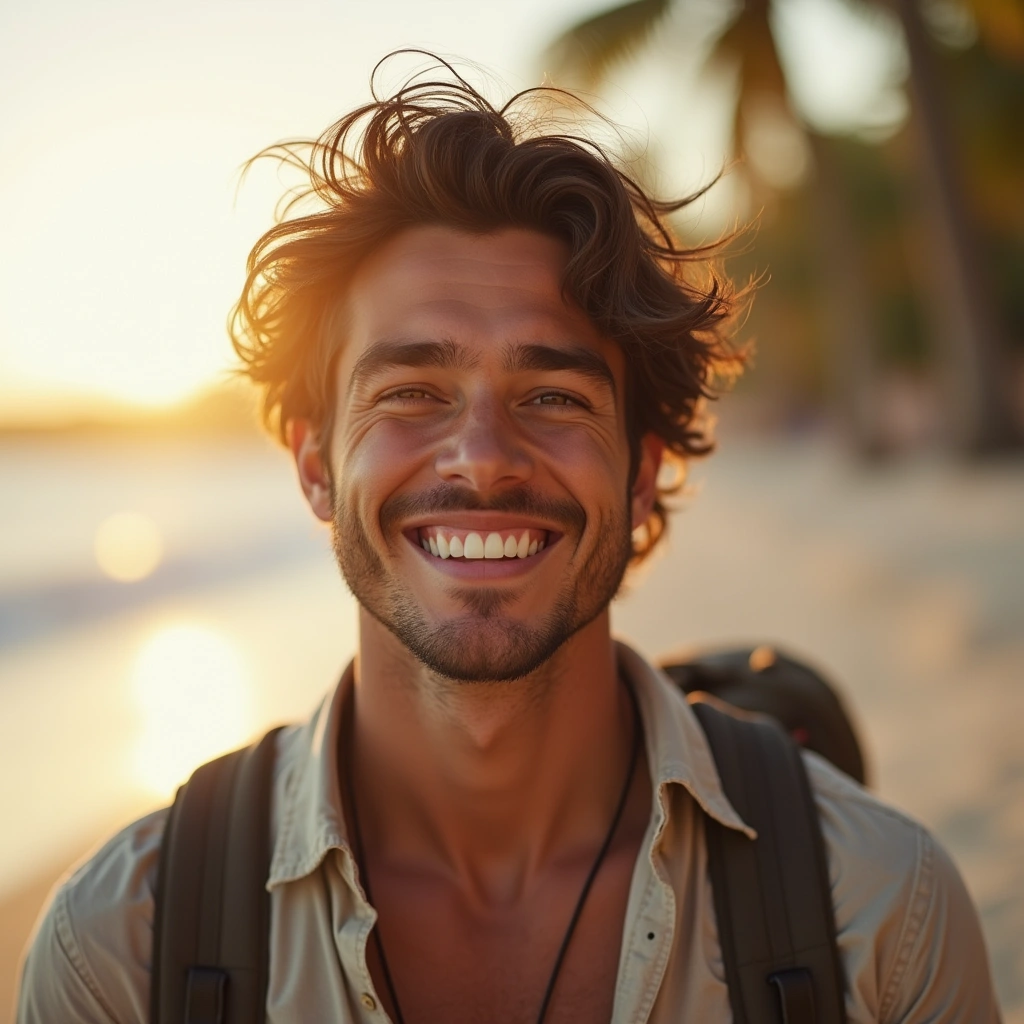Introduction: The Reality Behind the Wailua Falls “Hike”
Planning a Wailua Falls hike during your Kauai, Hawaii vacation? Here’s the truth you need to know before you go: there is NO official, sanctioned, or safe trail to the base of Wailua Falls. While these twin waterfalls cascade dramatically down volcanic cliffs, creating one of Hawaii’s most photographed natural wonders, the alleged “hike” to reach them is actually a dangerous, unofficial scramble down treacherous terrain.
Despite their breathtaking beauty and cultural significance in Hawaiian history, Wailua Falls is best experienced from the official viewpoint. In this comprehensive guide, we’ll uncover the reality behind the unofficial trail, explain the serious dangers involved, and share the safest ways to experience these magnificent falls while exploring fantastic alternatives in the Wailua River Valley.
Whether you’re seeking that perfect Instagram shot or simply want to witness nature’s power, this article will help you make informed decisions about visiting one of Kauai’s most beloved attractions safely and responsibly.
Table of Contents
The Unofficial “Wailua Falls Hike”: What You Need to Know
The “Trail” Explained: A Dangerous Descent
What many people call the “Wailua Falls hike” is actually an unofficial, unmaintained scramble down the steep cliffs beside the waterfall. This treacherous path involves:
- Steep, muddy terrain that becomes extremely slippery, especially after rain
- Loose rocks and unstable footing with potential for serious falls
- Dense vegetation that obscures hazards and makes navigation difficult
- No marked route or safety equipment along the descent
The so-called “trail” typically starts from the left side (when facing the falls) of the official viewpoint, descending roughly 80 feet down slippery, often muddy slopes to reach the pool at the base of the falls.
Why It’s Popular (and Misleading)
Social media has unfortunately popularized this dangerous descent, with countless photos showing people swimming in the pool below the falls. These images are often accompanied by hashtags like #WailuaFallsHike, creating the false impression that there’s a legitimate hiking trail.
Many outdated travel blogs and websites continue to reference this “trail,” either unaware of its dangers or failing to update their content with current safety information. This misinformation continues to draw unsuspecting visitors into dangerous situations.
Dangers & Risks: Why Experts Strongly Advise Against It
The unofficial path to Wailua Falls base presents multiple serious hazards:
Terrain Hazards
- Extremely steep slopes with loose volcanic rock
- Slippery conditions year-round, worsened by frequent tropical rain
- Falling rocks and debris from cliff faces above
- Hidden drop-offs obscured by thick vegetation
Weather-Related Dangers
- Flash flood potential – The pool can rise rapidly during rain
- Strong currents in the pool that can overpower swimmers
- Hypothermia risk from cold mountain water
Lack of Infrastructure
- No rescue access for emergency situations
- No cell phone service in the area
- No maintained trail markers or safety equipment
- No emergency resources readily available
Legality & Trespassing: The Legal Reality
The unofficial “Wailua Falls hike” crosses private property and areas not designated for public access. Visitors attempting this descent may face:
- Trespassing citations with fines up to $1,000
- Liability issues if accidents occur
- Legal consequences that can impact your vacation and future travel
The Hawaii Department of Land and Natural Resources (DLNR) has repeatedly issued warnings against attempting to access the falls’ base, emphasizing that the area is not open to public hiking or swimming.
Our Stance: We Do Not Recommend This “Hike”
We strongly advise against attempting the unofficial descent to Wailua Falls. The risks far outweigh any potential rewards, and the beauty of these falls can be fully appreciated from safe, legal viewing areas. Your safety and the preservation of this natural wonder should always come first.
The Official & Best Way to See Wailua Falls: The Viewpoint
Getting to the Wailua Falls Viewpoint
The safest and most spectacular way to experience Wailua Falls is from the official viewing area. Here’s how to get there:
Address: Maalo Road, Wailua, Kauai, HI (End of the road)
Driving Directions:
- From Lihue Airport: Head north on HI-56 (Kuhio Highway)
- Turn left on Maalo Road (approximately 3 miles from Lihue)
- Follow Maalo Road to the end (about 4 miles) – it becomes a winding mountain road
- The viewpoint parking area is at the road’s terminus
Parking Information:
- Free parking available in a small unpaved lot
- Limited capacity (about 30 vehicles)
- Best times to park: Early morning (before 9 AM) or late afternoon
- Peak crowds: 10 AM – 2 PM, especially on weekends
The viewpoint is wheelchair accessible from the parking area, with only a short, paved walk to the main viewing area.
What to Expect at the Viewpoint
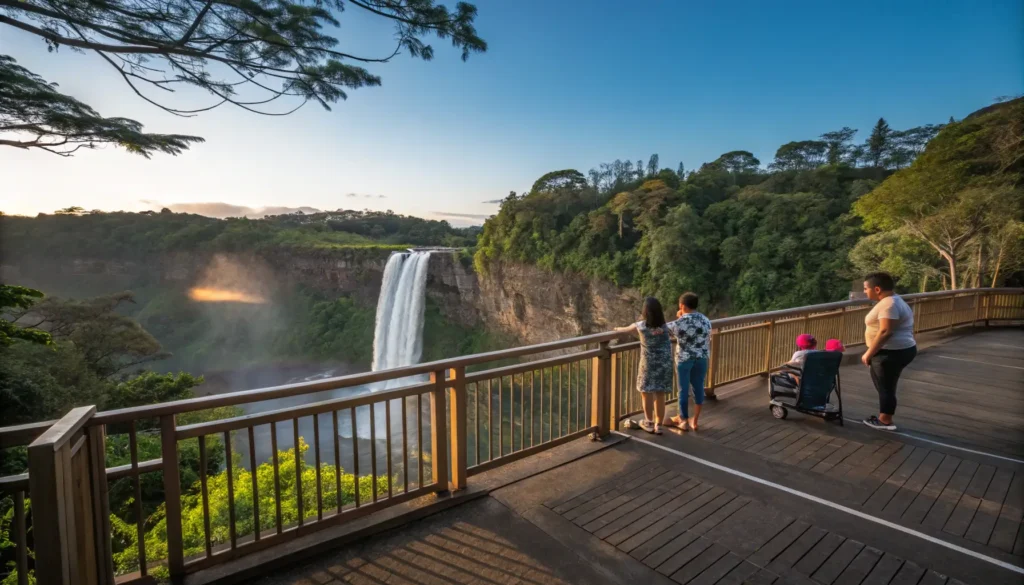
From the official viewpoint, you’ll enjoy:
Spectacular Views:
- Panoramic vistas of the twin waterfalls (approximately 80-173 feet tall)
- Multiple viewing angles from different sections of the platform
- Perfect photo opportunities without the danger
Best Times for Photography:
- Morning hours (8-10 AM): Often features rainbows in the mist
- Golden hour (30 minutes before sunset): Warm, dramatic lighting
- After rain: Falls are most impressive with increased water flow
Facilities:
- No restrooms at the viewpoint
- No food vendors or refreshment facilities
- Minimal shade – bring sun protection
Photography Tips for Wailua Falls
To capture the perfect shot from the viewpoint:
Equipment Recommendations:
- Wide-angle lens (14-24mm) for full falls in frame
- Telephoto lens (70-200mm) for detailed waterfall shots
- Circular polarizing filter to reduce glare and enhance colors
- ND filter for silky water effects
Shooting Tips:
- Arrive early for the best light and fewer crowds
- Look for rainbows in the morning mist
- Experiment with angles – both falls together or individually
- Include foreground elements like native plants for depth
Responsible Alternatives: Experiencing the Wailua River Area Safely
Wailua River Kayaking & Fern Grotto
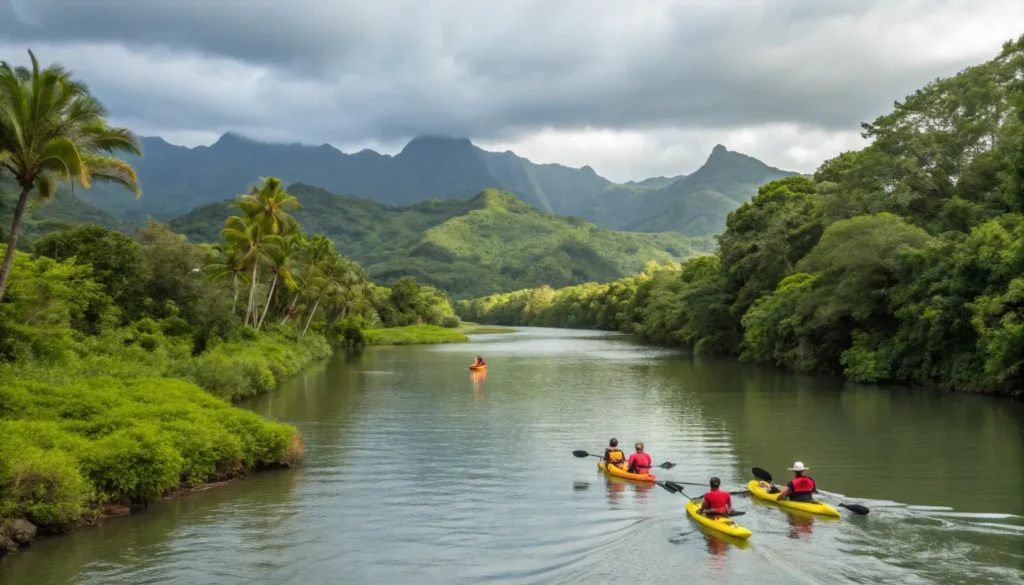
Experience the Wailua River Valley safely through guided kayaking tours: Fern Grotto is a lava rock cave lush with tropical ferns and was historically reserved for Hawaiian royalty ceremonies.
The Experience:
- Paddle up the sacred Wailua River to Fern Grotto
- Learn about Hawaiian history and native plants
- Enjoy a natural amphitheater carved from lava rock
- Average tour duration: 3-4 hours
Recommended Tour Operators:
- Choose licensed, local operators with excellent safety records
- Look for companies offering small group sizes
- Ensure they provide safety equipment and training
Hiking Official Trails Near Wailua River Valley
Explore legitimate hiking opportunities in the area:
Kuilau Ridge Trail
- Difficulty: Moderate
- Distance: 2.1 miles out and back
- Highlights: Mountain views, native forest
- Access: Well-marked trailhead with parking
Sleeping Giant Trail (Nounou Mountain)
- Difficulty: Moderate to Difficult
- Distance: 3.4 miles out and back
- Highlights: 360-degree views from the summit
- Access: Multiple trail approaches available
Other Nearby Waterfalls on Kauai with Safe Access
Consider these alternative waterfall experiences:
Opaeka’a Falls:
- Safe viewing from roadside pullout
- Easy access for all abilities
- Beautiful cascade through tropical vegetation
Ho’opi’i Falls:
- Short hike to swimming holes
- Legal access via established trail
- Less crowded than major attractions
Understanding Wailua Falls: History, Culture, and Legends
Historical Significance
Wailua Falls holds deep meaning in Hawaiian history:
- The area was once the royal center of Kauai, home to ancient ali’i (chiefs)
- The falls were considered wahi pana (sacred places) in traditional Hawaiian culture
- Ancient Hawaiians believed the falls were inhabited by mo’o (water spirits)
- The location served as a gathering place for important ceremonies
Cultural Importance
In Hawaiian tradition:
- The falls represent the connection between earth and sky
- Water was seen as a source of mana (spiritual power)
- Only ali’i had the spiritual power to leap from the falls (hence the ancient diving tradition)
- The area remains culturally significant to Native Hawaiians today
Geology of the Falls
Wailua Falls showcases Kauai’s volcanic origins:
- Formation: Created by ancient lava flows that carved through the landscape
- Twin nature: Result of erosional patterns in the basaltic rock
- Height variations: Water levels change seasonally and with rainfall
- Rock type: Primarily basalt typical of Hawaiian volcanic islands
Planning Your Visit to Wailua Falls (Viewpoint)
Best Time to Visit
Seasonal Considerations:
- November – April: Higher water levels due to increased rainfall
- May – October: Clearer days but potentially less water flow
- Rain seasons: Falls are more dramatic but viewpoint access may be slippery
Daily Timing:
- Early morning (7-9 AM): Best lighting, fewer crowds, potential rainbows
- Late afternoon (4-6 PM): Beautiful golden hour lighting
- Midday: Harsh lighting but falls are fully illuminated
What to Bring (for the viewpoint)
Essential Items:
| Item | Purpose |
| Camera/Phone | Capturing memories |
| Sunscreen | UV protection (minimal shade) |
| Water bottle | Stay hydrated |
| Hat/Sunglasses | Sun protection |
| Sturdy shoes | Uneven parking surface |
| Light rain jacket | Quick tropical showers |
Respectful Tourism
Practice responsible visiting:
Leave No Trace Principles: Visitors are encouraged to follow the Leave No Trace guidelines promoted by the National Park Service.
- Take only pictures, leave only footprints
- Stay on designated viewing areas
- Don’t climb or damage vegetation
- Pack out all trash
Cultural Respect:
- Understand the site’s spiritual significance
- Avoid loud behavior or disruptive activities
- Respect other visitors’ experiences
- Learn about Hawaiian culture and history
Accommodation Near Wailua Falls
Nearby Lodging Options:
- Kauai Coastal Resorts: 10-15 minutes drive to falls
- Kapaa Town: Various vacation rentals and hotels
- Princeville: Luxury resorts with stunning views (20 minutes)
Wailua Falls Hike FAQ
Q: Is there an official Wailua Falls hike?
No, there is no official, sanctioned trail to the base of Wailua Falls. The so-called “hike” is an unofficial, dangerous scramble down steep cliffs that authorities strongly discourage.
Q: Can you swim at Wailua Falls?
While there is a pool at the base of the falls, accessing it for swimming is extremely dangerous and involves crossing private property. We strongly recommend viewing the falls from the official viewpoint instead.
Q: Is the Wailua Falls hike illegal?
Yes, attempting to descend to the base involves trespassing on private property or areas not designated for public access. Visitors may face fines and legal consequences.
Q: How hard is the Wailua Falls hike?
The unofficial scramble to the base is extremely difficult and dangerous, involving steep, slippery terrain with no safety infrastructure. Emergency rescues are nearly impossible in this area.
Q: Where is the best view of Wailua Falls?
The official public viewpoint at the end of Maalo Road offers the best and safest viewing experience, with spectacular panoramic views of the twin waterfalls.
Q: How tall is Wailua Falls?
Wailua Falls is approximately 80-173 feet tall (sources vary), cascading down in two distinct streams that give it the nickname “twin falls.”
Q: What’s the best time to see rainbows at Wailua Falls?
Morning hours between 8-10 AM often feature beautiful rainbows formed by sunlight interacting with the waterfall’s mist.
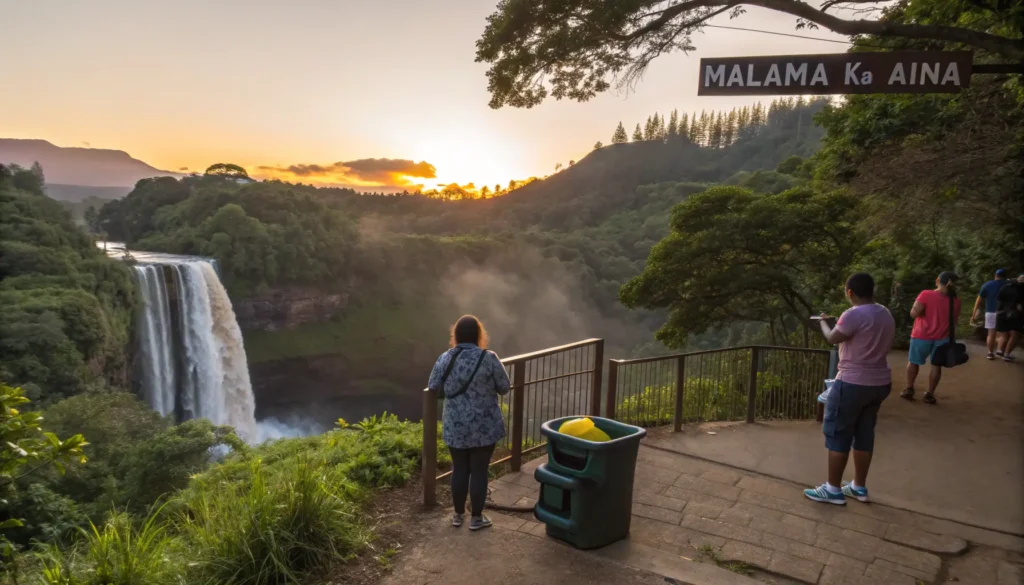
Conclusion & Final Thoughts
Wailua Falls stands as one of Kauai’s most magnificent natural treasures, offering visitors a glimpse into the raw power and beauty of Hawaiian nature. While the allure of getting closer to these spectacular waterfalls is understandable, the safest and most responsible way to experience them is from the designated viewpoint.
The official viewing area provides everything you need for an unforgettable experience: stunning panoramic views, excellent photography opportunities, and the chance to appreciate both the natural beauty and cultural significance of this sacred place. Remember, the unofficial “trail” to the base poses serious dangers and legal risks that simply aren’t worth it.
Instead, embrace the many safe alternatives the Wailua River Valley offers. From guided kayaking adventures to official hiking trails with breathtaking views, you can create lasting memories while respecting both your safety and this special place.
As you explore Kauai, remember that responsible tourism helps preserve these natural wonders for future generations. Share your beautiful Wailua Falls photos from the viewpoint, inspire others to visit safely, and continue exploring all that this incredible island has to offer through legitimate, sanctioned activities.
Ready to experience Wailua Falls safely? Plan your visit to the official viewpoint, and don’t miss our other comprehensive Kauai guides for more incredible, legal adventures on the Garden Isle!

